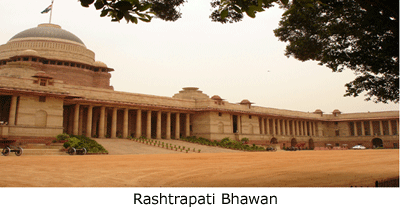|
The Viceroy Palace remains Lutyens most significant achievement. It is befittingly the crowning glory of the British Empire and architecture in India. Today, it is perhaps India’s best known monument after the Taj Mahal and the Qutub Minar. Bigger than the Palace of Versailles, it cost a whopping £12,53,000 and now houses the President of India. It is unquestionably a masterpiece of symmetry, discipline, silhouette, colour and harmony. of course, it has come in for much criticism too but that has mostly been limited to the imperial intent behind it rather than its architecture. Picturesque Location Better known now as the Rashtrapati Bhawan, the sprawling palace straddles the crown of Raisina Hill and is the focal point of New Delhi. The majestic Rajpath (earlier Kings Way) leads up to the palace on Raisina Hill and here comes into view the one fatal flaw in design. Lutyens and Baker had a major showdown about the height of the slope approaching the palace which was at that time caricatured as the ‘War of the Gradient’. Lutyens wanted the palace to come into view as one climbed Raisina Hill. Unfortunately, Baker miscalculated. The palace disappears from sight till only the copper dome is visible. Furious with Baker, Lutyens said he had ‘met his Bakerloo’. The palace is flanked by the two Secretariats and the three together, open into a huge square called the Viceroy’s Court where the Jaipur Column stands tall. The Viceroys Court, which frames the main entrance to the house, has lateral entrances on the axis of the Jaipur Column. Here the levels were reduced artificially and cascades of steps are flanked by huge sandstone elephants and ranks of imperial lions modelled by the sculptor C.S. Jagger. The Attractions of The Palace The main entrance is approached by a broad flight of steps which lead to a 12-column portico. Do notice the enormous projecting cornice or chajja, a Mughal device, which blends so effortlessly with the classical style of the monument. Lutyens’ ability to smoothly incorporate light oriental touches is all the more remarkable given his active and profound dislike for Indian architecture. The most outstanding feature of the House – you can spot it while you are still a kilometre away – is the huge neo-Buddhist copper dome that rises over a vast colonnaded frontage. Beneath the dome is the circular Durbar Hall 22.8m in diameter. The coloured marbles used in the hall come from all parts of India. The Viceroy’s throne, ceremonially placed in this chamber, faced the main entrance and commanded a view along the great axial vista of Kingsway (now Rajpath). At present the hall is the venue of all official ceremonies such as the swearing in of the Prime Minister, the Cabinet and the Members of Parliament. It is in this very chamber that the President annually confers the Arjuna Awards for Excellence. The columns at the front entrance have bells carved into their capitals. Lutyens reasoned that ‘the ringing of bells sound the end of an empire and stone bells never sound’. Despite this, the empire came to an end a brief 16 years later. The Great Interiors The principal floor comprises a magnificent series of state apartments. The State Drawing Room is barrel-vaulted and plainly treated with domestic fireplaces. The State Ballroom is enriched with Old English mirror glass. The State Library is based on the form of Wren’s St Stephen’s, Walbrook. The State Dining Room is lined with teak panelling enriched with the star of India. The concept of Imperial order and hierarchy permeates the entire house. Marble staircases flanking the Durbar Hall provide access to the private apartments above. There are 54 bedrooms together with additional accommodation for guests. Lord Irwin, its first occupant, ‘kept losing his way’ but insisted that "in spite of its size, it was essentially a liveable-in-house." Mughal Garden To the west the palace overlooks an enormous Mughal garden designed by Lutyens. Here the principles of hierarchy, order, symmetry and unity are extended from the house into the landscape. A series of ornamental fountains, walls, gazebos and screens combine with scores of trees, flowers and shrubs to create a paradise so delightful that Indians called the garden ‘God’s own Heaven’. The Irwins supervised the planting of the garden which grew in tropical profusion softening the formal pattern of lawns and waterways. Popularly known as the Mughal Garden, it is open to public every spring but be prepared for the tight security check. The Glory of The Palace After India became independent, the sheer size of the building overwhelmed its new keepers. Mahatma Gandhi suggested it be turned into a hospital. Thankfully, nobody took him seriously. The Durbar Hall served as a museum for several years till the building which now houses the National Museum was completed. Here’s what Mark-Bence Jones remarked about life at the Viceroy’s House in his book Palaces of the Raj. Do note the then-and-now comparison he makes on a later visit to the palace, long after the British had gone. "Then there were the banquets held during sessions of the Chamber of Princes, when every other guest at the long table was the ruler of a State. The gold plate glittered in its crimson-lined niche, the lustres glinted, the scarlet and gold khitmagars moved deftly against the teak-panelled walls, and from an adjoining room came the music of the Viceroy’s band." "In India that replaced the Raj, Lutyens’ Palace has managed to keep some of its glory. …As the home of a modern democratic President, it is certainly on the large side, but the Indians have been wise enough to maintain a Presidential establishment worthy of the setting. Scarlet-clad guards still sit on their chargers beneath the stone sentry boxes, khitmagars in white, red and gold line the corridors." |
|||||||
|
|
|||||||




